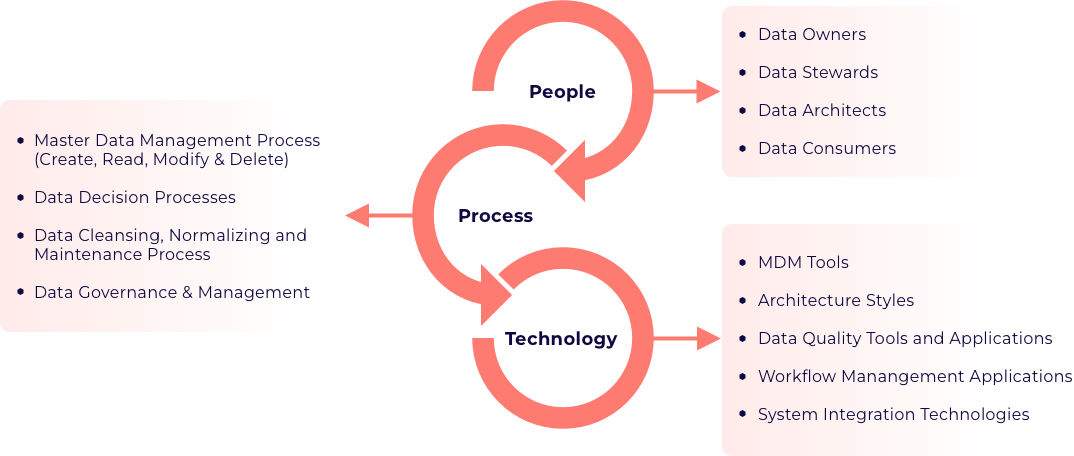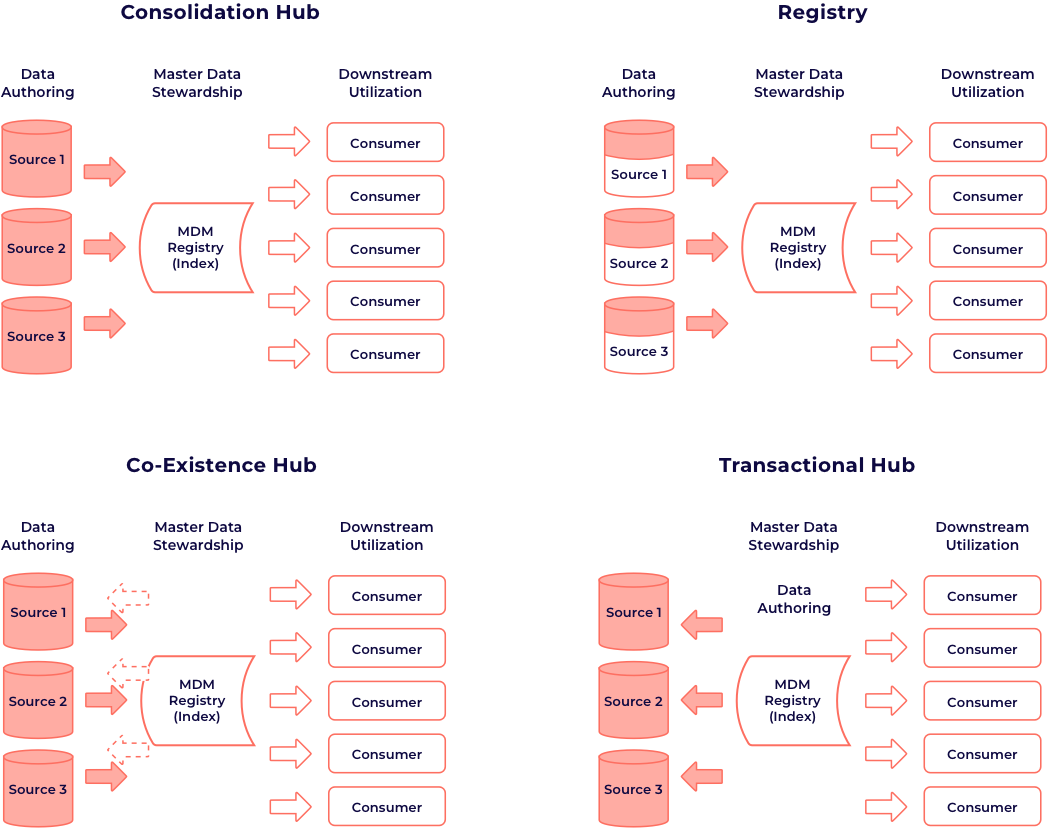Share your requirements and we'll get back to you with how we can help.
Thank you for submitting your request.
We will get back to you shortly.
Master Data Management
Services
Is your enterprise backed by quality data—data that is complete, accurate, relevant, and timely? It all depends on the quality of master data management.


Master Data Management for Single Source of Truth
As organizations grow, so do the number of applications, each with its own set of data definitions, table structures, etc., giving rise to multiple versions of truth within the enterprise. While this may not impede the work of individual units, it impairs executive ability to take decisions on the enterprise’s behalf. Adverse impacts on customer relations and erroneous financial reporting are not unusual when data is faulty and information is misrepresented.
Master data management (MDM) helps tide over the data fragmentation problem through the centralized governance and control of shared data on key entities like customers, suppliers, products, assets, locations, etc. MDM standardizes this non-transactional data used across functions to create a trusted single source of truth for decision-making.
MDM Components: People, Process, Technology
A triad of influences shapes the success of MDM: people, process, and technology. Cross-functional collaboration by application owners, business analysts, information architects, data stewards, developers, and system operators is required to create a sustainable MDM program. Processes define how data is collected, aggregated, controlled for quality, persisted, and provisioned. Technology involves tools deployed to carry out various MDM processes and architecture that aligns with business needs.

Why Is Master Data Management So Challenging?
Organizations change over time: firms merge, departments consolidate or split, policies change, applications are introduced or retired. In this process, organizations develop information silos and other data-related issues such as:
- Duplication and fragmentation of data such as basic customer records, which leads to inconsistencies in reporting.
- Disparities in data structure, such as when customer address is treated as a single text field in one application and structured data with multiple fields in another.
- Adoption of multiple standards to describe the properties of an entity, such as the color or size of a product.
- Governance issues such as lack of clarity on who would manage what data and what should be the quality criteria.
Apart from technical and organizational challenges, there is the issue of finding skilled partners. The partners should have technical, organizational, and business perspectives to drive MDM projects. Building a compelling case for MDM is necessary to get higher-level buy-in for the initiative. The business case must effectively communicate to all levels of management. Indicators need to be developed to monitor the impact of the MDM initiative.

Data Governance: The
Pre-Condition for MDM
No data management is complete without a data governance system. MDM is no different. Ensuring MDM provides accurate and up-to-date data depends on data governance. It involves standardizing definitions, assigning roles and responsibilities to different people, defining workflows for collaboration, and the metrics for measuring data quality.
Data governance enables you to:
- Comply with data regulations
- Improve transparency in data management
- Standardize policies and processes to handle data
- Improve monitoring of data for quality assurance
9 Steps in MDM Implementation
- 1Identify sources of data, the producers, and consumers
- 2Analyze metadata and establish data standards
- 3Appoint data stewards to prepare master data from various sources
- 4Establish data governance structures
- 5Build master data model
- 6Set up tools and processes to transform and clean data
- 7Set up the infrastructure to manage and provision master data
- 8Test and re-configure data producers and consumers as needed
- 9Establish maintenance processes
3 Essentials of MDM Success
Strong Business Case
Having a strong business case is fundamental to any undertaking but with MDM it is even more important as it introduces new processes and policies that may require resource reallocation and rollback of existing practices. All of this is difficult to justify in the absence of a strong use case.
While rectification of data quality issues is one of the objectives of MDM, a business case aims bigger and seeks to have a measurable impact such as cost savings, profitability, efficiency gains, or risk mitigation. One way to do it is to establish a cause-effect relationship between a data problem and its impact on business outcomes.
Starting Small
The aphorism “think big, start small” applies to MDM. It is easier for projects that are enormous in scope to crash and burn than it is for smaller projects to show a demonstrable difference. This is because large projects tend to unearth too many problems, which cannot be satisfactorily resolved within a short timeline.
A phased approach, starting from the most immediate need or problem, is best for quick wins, which in turn can get executive buy-in for extending the initiative to other problem domains. Thinking big matters because the master data program you initiate should stand you in good stead in the future in terms of scalability or supporting new business needs.
The Right Architecture
The MDM architecture should be suited to the business case. In the Consolidation model, master data is consolidated in an existing application or a new repository. In the Registry model, the hub does not contain records but points to data sources in the enterprise. Unique identifiers are assigned by the registry for all entities and a real-time view of data is constructed through queries.

The Coexistence model is similar to the Consolidation model, except that the master data is also updated in the source applications. In the Transactional Hub model, changes in MDM are listened to by the sources and they update accordingly. These architecture paradigms are not mutually exclusive; a judicious combination is the key.
Strong Business Case
Having a strong business case is fundamental to any undertaking but with MDM it is even more important as it introduces new processes and policies that may require resource reallocation and rollback of existing practices. All of this is difficult to justify in the absence of a strong use case.
While rectification of data quality issues is one of the objectives of MDM, a business case aims bigger and seeks to have a measurable impact such as cost savings, profitability, efficiency gains, or risk mitigation. One way to do it is to establish a cause-effect relationship between a data problem and its impact on business outcomes.
Starting Small
The aphorism “think big, start small” applies to MDM. It is easier for projects that are enormous in scope to crash and burn than it is for smaller projects to show a demonstrable difference. This is because large projects tend to unearth too many problems, which cannot be satisfactorily resolved within a short timeline.
A phased approach, starting from the most immediate need or problem, is best for quick wins, which in turn can get executive buy-in for extending the initiative to other problem domains. Thinking big matters because the master data program you initiate should stand you in good stead in the future in terms of scalability or supporting new business needs.
The Right Architecture
The MDM architecture should be suited to the business case. In the Consolidation model, master data is consolidated in an existing application or a new repository. In the Registry model, the hub does not contain records but points to data sources in the enterprise. Unique identifiers are assigned by the registry for all entities and a real-time view of data is constructed through queries.
The Coexistence model is similar to the Consolidation model, except that the master data is also updated in the source applications. In the Transactional Hub model, changes in MDM are listened to by the sources and they update accordingly. These architecture paradigms are not mutually exclusive; a judicious combination is the key.
